Assessing Solid Waste Management: Legal & Financial Aspects in Vietnam
VerifiedAdded on 2023/06/05
|13
|3684
|429
Report
AI Summary
This report provides a comprehensive analysis of municipal solid waste management in Vietnam, addressing legal, financial, and operational aspects related to waste collection, treatment, disposal, and transportation. It examines the ecosystem service analysis and property rights assessment applied by the Vietnamese government, highlighting the theoretical ecosystem framework used in response to integrated sustainability waste management. The report discusses current regulatory and policy mechanisms, including the Environmental Protection Law and technological treatments like biogas plants and landfilling. It appraises the current regulatory and policy frameworks, identifying shortcomings such as unhealthy landfilling practices and challenges in technological waste treatment due to limited resources and equipment. The report emphasizes the potential social inefficiencies and sub-optimal waste management practices resulting from these shortcomings, particularly their effects on ecosystem service delivery, including water and soil contamination and air pollution.
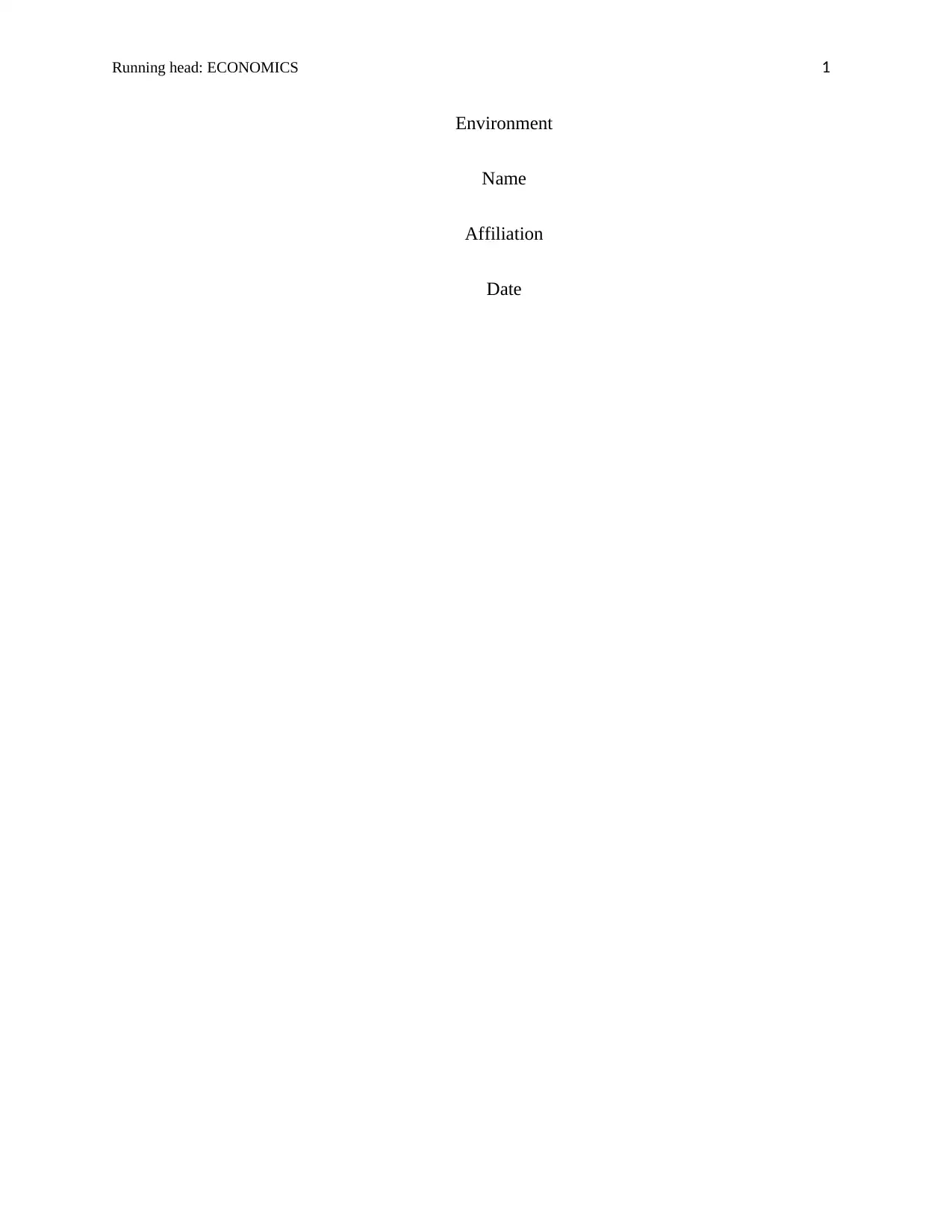
Running head: ECONOMICS 1
Environment
Name
Affiliation
Date
Environment
Name
Affiliation
Date
Paraphrase This Document
Need a fresh take? Get an instant paraphrase of this document with our AI Paraphraser
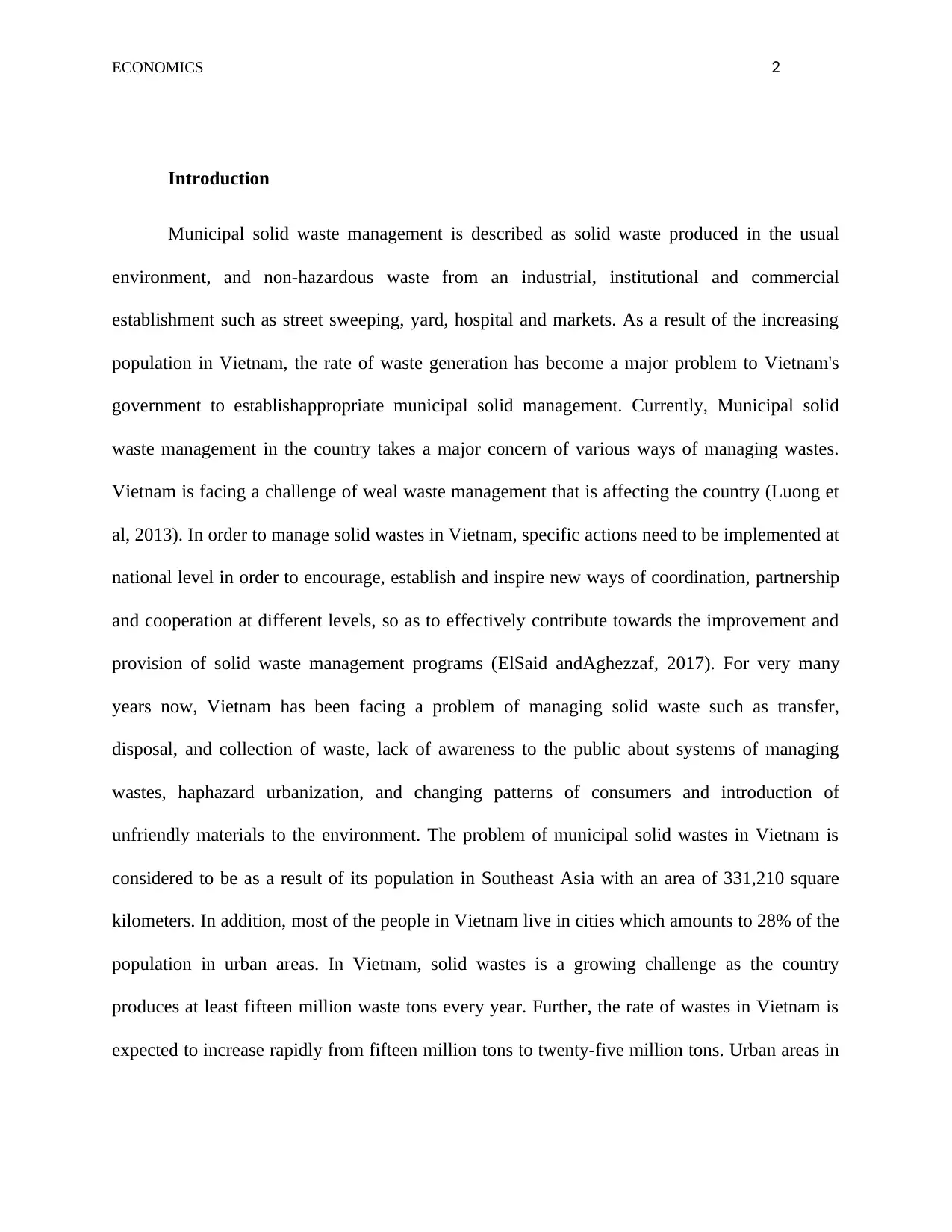
ECONOMICS 2
Introduction
Municipal solid waste management is described as solid waste produced in the usual
environment, and non-hazardous waste from an industrial, institutional and commercial
establishment such as street sweeping, yard, hospital and markets. As a result of the increasing
population in Vietnam, the rate of waste generation has become a major problem to Vietnam's
government to establishappropriate municipal solid management. Currently, Municipal solid
waste management in the country takes a major concern of various ways of managing wastes.
Vietnam is facing a challenge of weal waste management that is affecting the country (Luong et
al, 2013). In order to manage solid wastes in Vietnam, specific actions need to be implemented at
national level in order to encourage, establish and inspire new ways of coordination, partnership
and cooperation at different levels, so as to effectively contribute towards the improvement and
provision of solid waste management programs (ElSaid andAghezzaf, 2017). For very many
years now, Vietnam has been facing a problem of managing solid waste such as transfer,
disposal, and collection of waste, lack of awareness to the public about systems of managing
wastes, haphazard urbanization, and changing patterns of consumers and introduction of
unfriendly materials to the environment. The problem of municipal solid wastes in Vietnam is
considered to be as a result of its population in Southeast Asia with an area of 331,210 square
kilometers. In addition, most of the people in Vietnam live in cities which amounts to 28% of the
population in urban areas. In Vietnam, solid wastes is a growing challenge as the country
produces at least fifteen million waste tons every year. Further, the rate of wastes in Vietnam is
expected to increase rapidly from fifteen million tons to twenty-five million tons. Urban areas in
Introduction
Municipal solid waste management is described as solid waste produced in the usual
environment, and non-hazardous waste from an industrial, institutional and commercial
establishment such as street sweeping, yard, hospital and markets. As a result of the increasing
population in Vietnam, the rate of waste generation has become a major problem to Vietnam's
government to establishappropriate municipal solid management. Currently, Municipal solid
waste management in the country takes a major concern of various ways of managing wastes.
Vietnam is facing a challenge of weal waste management that is affecting the country (Luong et
al, 2013). In order to manage solid wastes in Vietnam, specific actions need to be implemented at
national level in order to encourage, establish and inspire new ways of coordination, partnership
and cooperation at different levels, so as to effectively contribute towards the improvement and
provision of solid waste management programs (ElSaid andAghezzaf, 2017). For very many
years now, Vietnam has been facing a problem of managing solid waste such as transfer,
disposal, and collection of waste, lack of awareness to the public about systems of managing
wastes, haphazard urbanization, and changing patterns of consumers and introduction of
unfriendly materials to the environment. The problem of municipal solid wastes in Vietnam is
considered to be as a result of its population in Southeast Asia with an area of 331,210 square
kilometers. In addition, most of the people in Vietnam live in cities which amounts to 28% of the
population in urban areas. In Vietnam, solid wastes is a growing challenge as the country
produces at least fifteen million waste tons every year. Further, the rate of wastes in Vietnam is
expected to increase rapidly from fifteen million tons to twenty-five million tons. Urban areas in
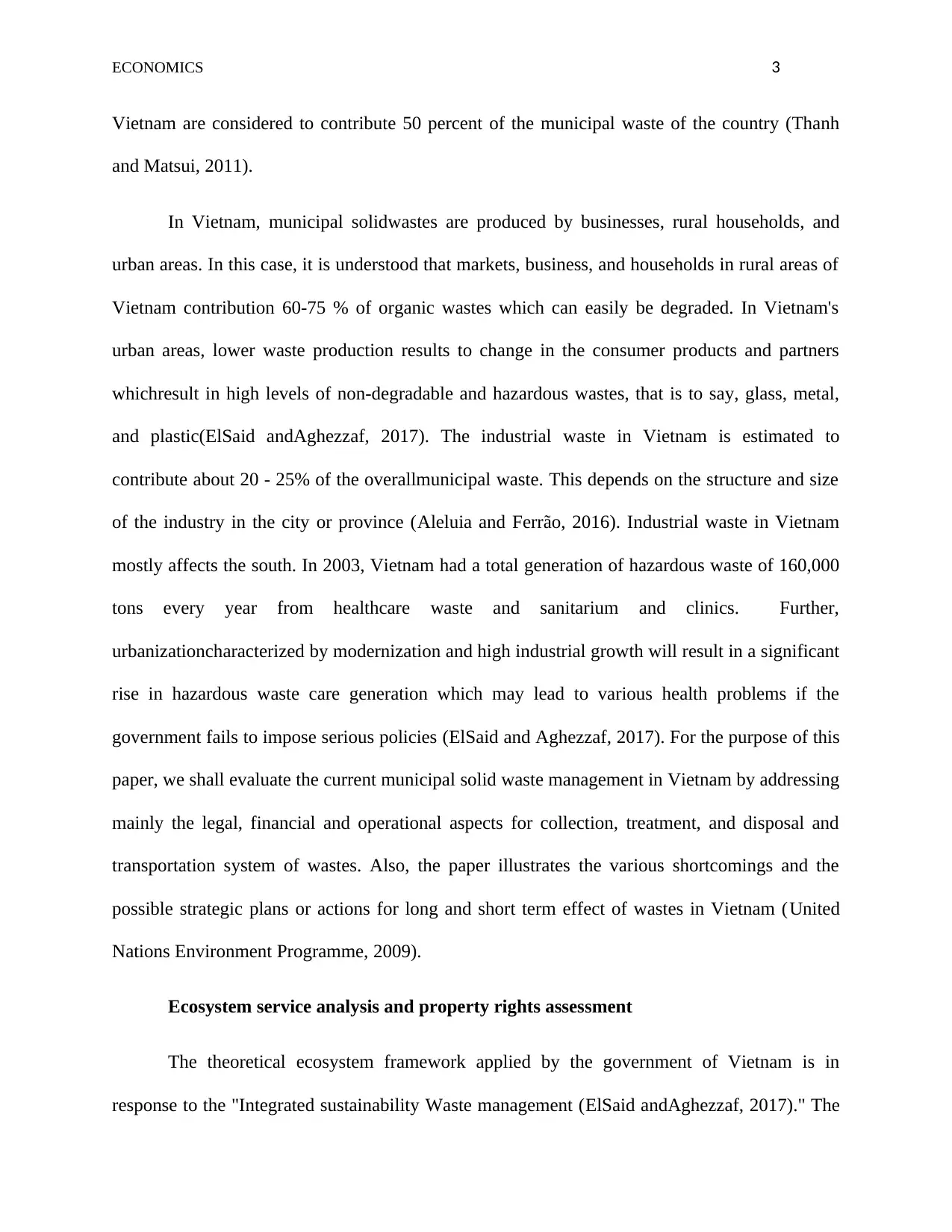
ECONOMICS 3
Vietnam are considered to contribute 50 percent of the municipal waste of the country (Thanh
and Matsui, 2011).
In Vietnam, municipal solidwastes are produced by businesses, rural households, and
urban areas. In this case, it is understood that markets, business, and households in rural areas of
Vietnam contribution 60-75 % of organic wastes which can easily be degraded. In Vietnam's
urban areas, lower waste production results to change in the consumer products and partners
whichresult in high levels of non-degradable and hazardous wastes, that is to say, glass, metal,
and plastic(ElSaid andAghezzaf, 2017). The industrial waste in Vietnam is estimated to
contribute about 20 - 25% of the overallmunicipal waste. This depends on the structure and size
of the industry in the city or province (Aleluia and Ferrão, 2016). Industrial waste in Vietnam
mostly affects the south. In 2003, Vietnam had a total generation of hazardous waste of 160,000
tons every year from healthcare waste and sanitarium and clinics. Further,
urbanizationcharacterized by modernization and high industrial growth will result in a significant
rise in hazardous waste care generation which may lead to various health problems if the
government fails to impose serious policies (ElSaid and Aghezzaf, 2017). For the purpose of this
paper, we shall evaluate the current municipal solid waste management in Vietnam by addressing
mainly the legal, financial and operational aspects for collection, treatment, and disposal and
transportation system of wastes. Also, the paper illustrates the various shortcomings and the
possible strategic plans or actions for long and short term effect of wastes in Vietnam (United
Nations Environment Programme, 2009).
Ecosystem service analysis and property rights assessment
The theoretical ecosystem framework applied by the government of Vietnam is in
response to the "Integrated sustainability Waste management (ElSaid andAghezzaf, 2017)." The
Vietnam are considered to contribute 50 percent of the municipal waste of the country (Thanh
and Matsui, 2011).
In Vietnam, municipal solidwastes are produced by businesses, rural households, and
urban areas. In this case, it is understood that markets, business, and households in rural areas of
Vietnam contribution 60-75 % of organic wastes which can easily be degraded. In Vietnam's
urban areas, lower waste production results to change in the consumer products and partners
whichresult in high levels of non-degradable and hazardous wastes, that is to say, glass, metal,
and plastic(ElSaid andAghezzaf, 2017). The industrial waste in Vietnam is estimated to
contribute about 20 - 25% of the overallmunicipal waste. This depends on the structure and size
of the industry in the city or province (Aleluia and Ferrão, 2016). Industrial waste in Vietnam
mostly affects the south. In 2003, Vietnam had a total generation of hazardous waste of 160,000
tons every year from healthcare waste and sanitarium and clinics. Further,
urbanizationcharacterized by modernization and high industrial growth will result in a significant
rise in hazardous waste care generation which may lead to various health problems if the
government fails to impose serious policies (ElSaid and Aghezzaf, 2017). For the purpose of this
paper, we shall evaluate the current municipal solid waste management in Vietnam by addressing
mainly the legal, financial and operational aspects for collection, treatment, and disposal and
transportation system of wastes. Also, the paper illustrates the various shortcomings and the
possible strategic plans or actions for long and short term effect of wastes in Vietnam (United
Nations Environment Programme, 2009).
Ecosystem service analysis and property rights assessment
The theoretical ecosystem framework applied by the government of Vietnam is in
response to the "Integrated sustainability Waste management (ElSaid andAghezzaf, 2017)." The
⊘ This is a preview!⊘
Do you want full access?
Subscribe today to unlock all pages.

Trusted by 1+ million students worldwide
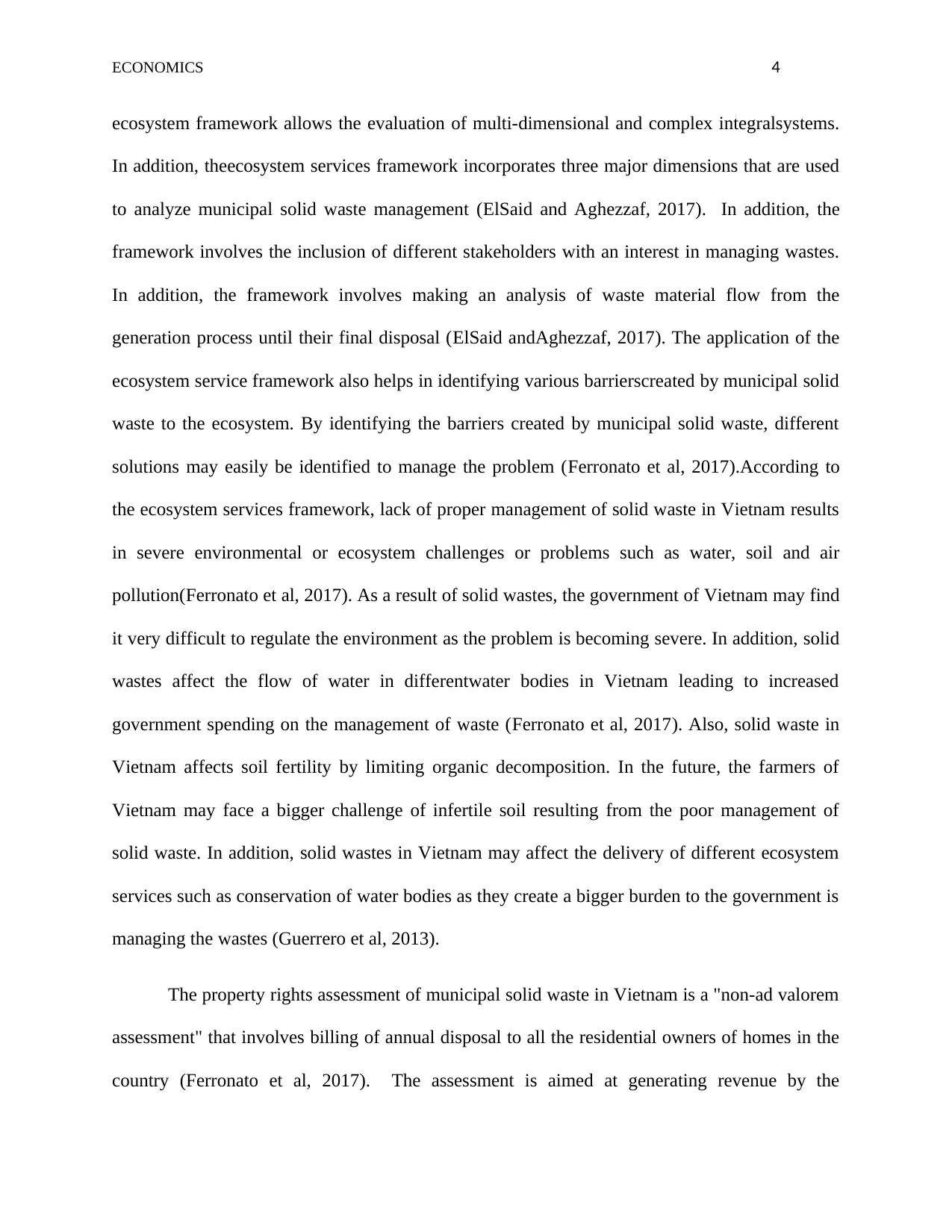
ECONOMICS 4
ecosystem framework allows the evaluation of multi-dimensional and complex integralsystems.
In addition, theecosystem services framework incorporates three major dimensions that are used
to analyze municipal solid waste management (ElSaid and Aghezzaf, 2017). In addition, the
framework involves the inclusion of different stakeholders with an interest in managing wastes.
In addition, the framework involves making an analysis of waste material flow from the
generation process until their final disposal (ElSaid andAghezzaf, 2017). The application of the
ecosystem service framework also helps in identifying various barrierscreated by municipal solid
waste to the ecosystem. By identifying the barriers created by municipal solid waste, different
solutions may easily be identified to manage the problem (Ferronato et al, 2017).According to
the ecosystem services framework, lack of proper management of solid waste in Vietnam results
in severe environmental or ecosystem challenges or problems such as water, soil and air
pollution(Ferronato et al, 2017). As a result of solid wastes, the government of Vietnam may find
it very difficult to regulate the environment as the problem is becoming severe. In addition, solid
wastes affect the flow of water in differentwater bodies in Vietnam leading to increased
government spending on the management of waste (Ferronato et al, 2017). Also, solid waste in
Vietnam affects soil fertility by limiting organic decomposition. In the future, the farmers of
Vietnam may face a bigger challenge of infertile soil resulting from the poor management of
solid waste. In addition, solid wastes in Vietnam may affect the delivery of different ecosystem
services such as conservation of water bodies as they create a bigger burden to the government is
managing the wastes (Guerrero et al, 2013).
The property rights assessment of municipal solid waste in Vietnam is a "non-ad valorem
assessment" that involves billing of annual disposal to all the residential owners of homes in the
country (Ferronato et al, 2017). The assessment is aimed at generating revenue by the
ecosystem framework allows the evaluation of multi-dimensional and complex integralsystems.
In addition, theecosystem services framework incorporates three major dimensions that are used
to analyze municipal solid waste management (ElSaid and Aghezzaf, 2017). In addition, the
framework involves the inclusion of different stakeholders with an interest in managing wastes.
In addition, the framework involves making an analysis of waste material flow from the
generation process until their final disposal (ElSaid andAghezzaf, 2017). The application of the
ecosystem service framework also helps in identifying various barrierscreated by municipal solid
waste to the ecosystem. By identifying the barriers created by municipal solid waste, different
solutions may easily be identified to manage the problem (Ferronato et al, 2017).According to
the ecosystem services framework, lack of proper management of solid waste in Vietnam results
in severe environmental or ecosystem challenges or problems such as water, soil and air
pollution(Ferronato et al, 2017). As a result of solid wastes, the government of Vietnam may find
it very difficult to regulate the environment as the problem is becoming severe. In addition, solid
wastes affect the flow of water in differentwater bodies in Vietnam leading to increased
government spending on the management of waste (Ferronato et al, 2017). Also, solid waste in
Vietnam affects soil fertility by limiting organic decomposition. In the future, the farmers of
Vietnam may face a bigger challenge of infertile soil resulting from the poor management of
solid waste. In addition, solid wastes in Vietnam may affect the delivery of different ecosystem
services such as conservation of water bodies as they create a bigger burden to the government is
managing the wastes (Guerrero et al, 2013).
The property rights assessment of municipal solid waste in Vietnam is a "non-ad valorem
assessment" that involves billing of annual disposal to all the residential owners of homes in the
country (Ferronato et al, 2017). The assessment is aimed at generating revenue by the
Paraphrase This Document
Need a fresh take? Get an instant paraphrase of this document with our AI Paraphraser
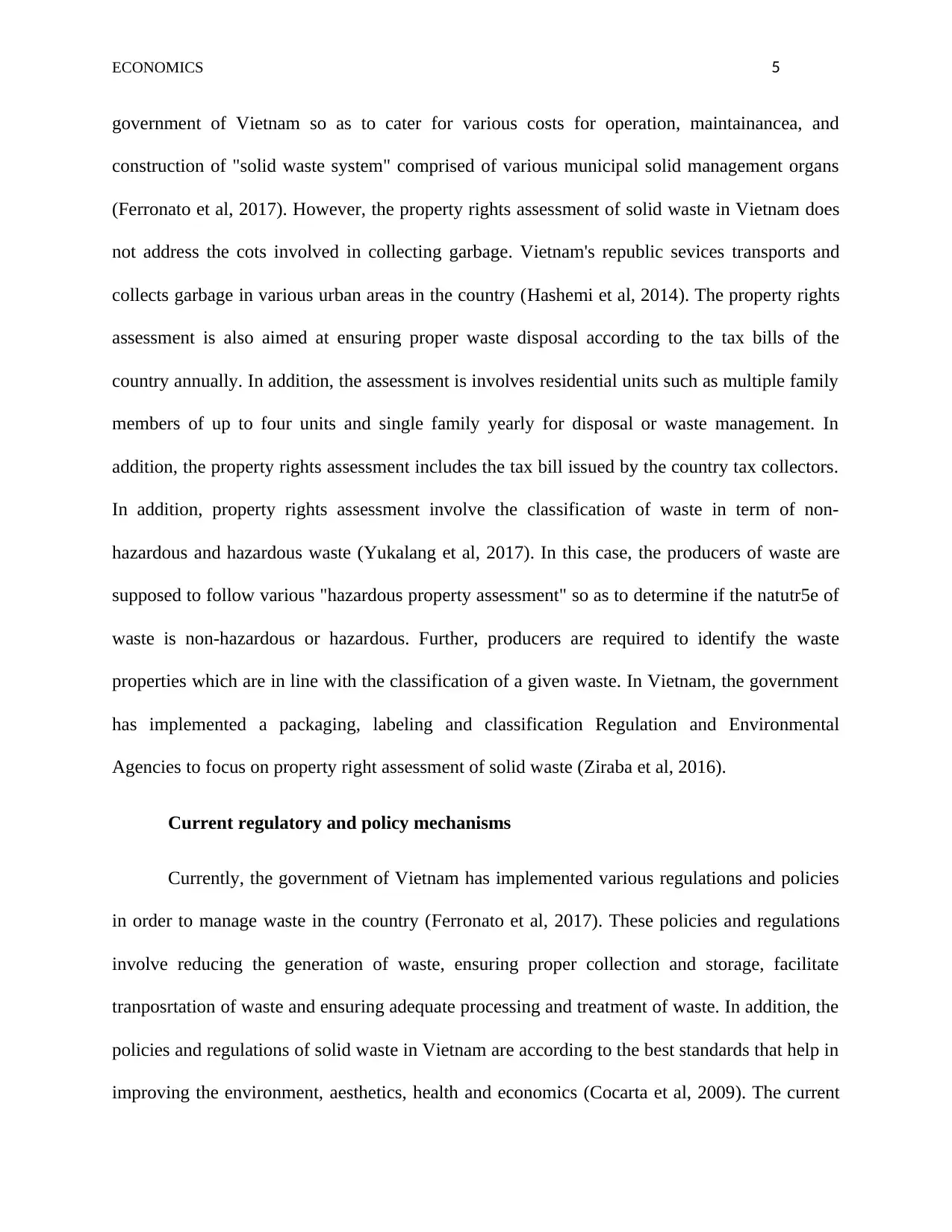
ECONOMICS 5
government of Vietnam so as to cater for various costs for operation, maintainancea, and
construction of "solid waste system" comprised of various municipal solid management organs
(Ferronato et al, 2017). However, the property rights assessment of solid waste in Vietnam does
not address the cots involved in collecting garbage. Vietnam's republic sevices transports and
collects garbage in various urban areas in the country (Hashemi et al, 2014). The property rights
assessment is also aimed at ensuring proper waste disposal according to the tax bills of the
country annually. In addition, the assessment is involves residential units such as multiple family
members of up to four units and single family yearly for disposal or waste management. In
addition, the property rights assessment includes the tax bill issued by the country tax collectors.
In addition, property rights assessment involve the classification of waste in term of non-
hazardous and hazardous waste (Yukalang et al, 2017). In this case, the producers of waste are
supposed to follow various "hazardous property assessment" so as to determine if the natutr5e of
waste is non-hazardous or hazardous. Further, producers are required to identify the waste
properties which are in line with the classification of a given waste. In Vietnam, the government
has implemented a packaging, labeling and classification Regulation and Environmental
Agencies to focus on property right assessment of solid waste (Ziraba et al, 2016).
Current regulatory and policy mechanisms
Currently, the government of Vietnam has implemented various regulations and policies
in order to manage waste in the country (Ferronato et al, 2017). These policies and regulations
involve reducing the generation of waste, ensuring proper collection and storage, facilitate
tranposrtation of waste and ensuring adequate processing and treatment of waste. In addition, the
policies and regulations of solid waste in Vietnam are according to the best standards that help in
improving the environment, aesthetics, health and economics (Cocarta et al, 2009). The current
government of Vietnam so as to cater for various costs for operation, maintainancea, and
construction of "solid waste system" comprised of various municipal solid management organs
(Ferronato et al, 2017). However, the property rights assessment of solid waste in Vietnam does
not address the cots involved in collecting garbage. Vietnam's republic sevices transports and
collects garbage in various urban areas in the country (Hashemi et al, 2014). The property rights
assessment is also aimed at ensuring proper waste disposal according to the tax bills of the
country annually. In addition, the assessment is involves residential units such as multiple family
members of up to four units and single family yearly for disposal or waste management. In
addition, the property rights assessment includes the tax bill issued by the country tax collectors.
In addition, property rights assessment involve the classification of waste in term of non-
hazardous and hazardous waste (Yukalang et al, 2017). In this case, the producers of waste are
supposed to follow various "hazardous property assessment" so as to determine if the natutr5e of
waste is non-hazardous or hazardous. Further, producers are required to identify the waste
properties which are in line with the classification of a given waste. In Vietnam, the government
has implemented a packaging, labeling and classification Regulation and Environmental
Agencies to focus on property right assessment of solid waste (Ziraba et al, 2016).
Current regulatory and policy mechanisms
Currently, the government of Vietnam has implemented various regulations and policies
in order to manage waste in the country (Ferronato et al, 2017). These policies and regulations
involve reducing the generation of waste, ensuring proper collection and storage, facilitate
tranposrtation of waste and ensuring adequate processing and treatment of waste. In addition, the
policies and regulations of solid waste in Vietnam are according to the best standards that help in
improving the environment, aesthetics, health and economics (Cocarta et al, 2009). The current
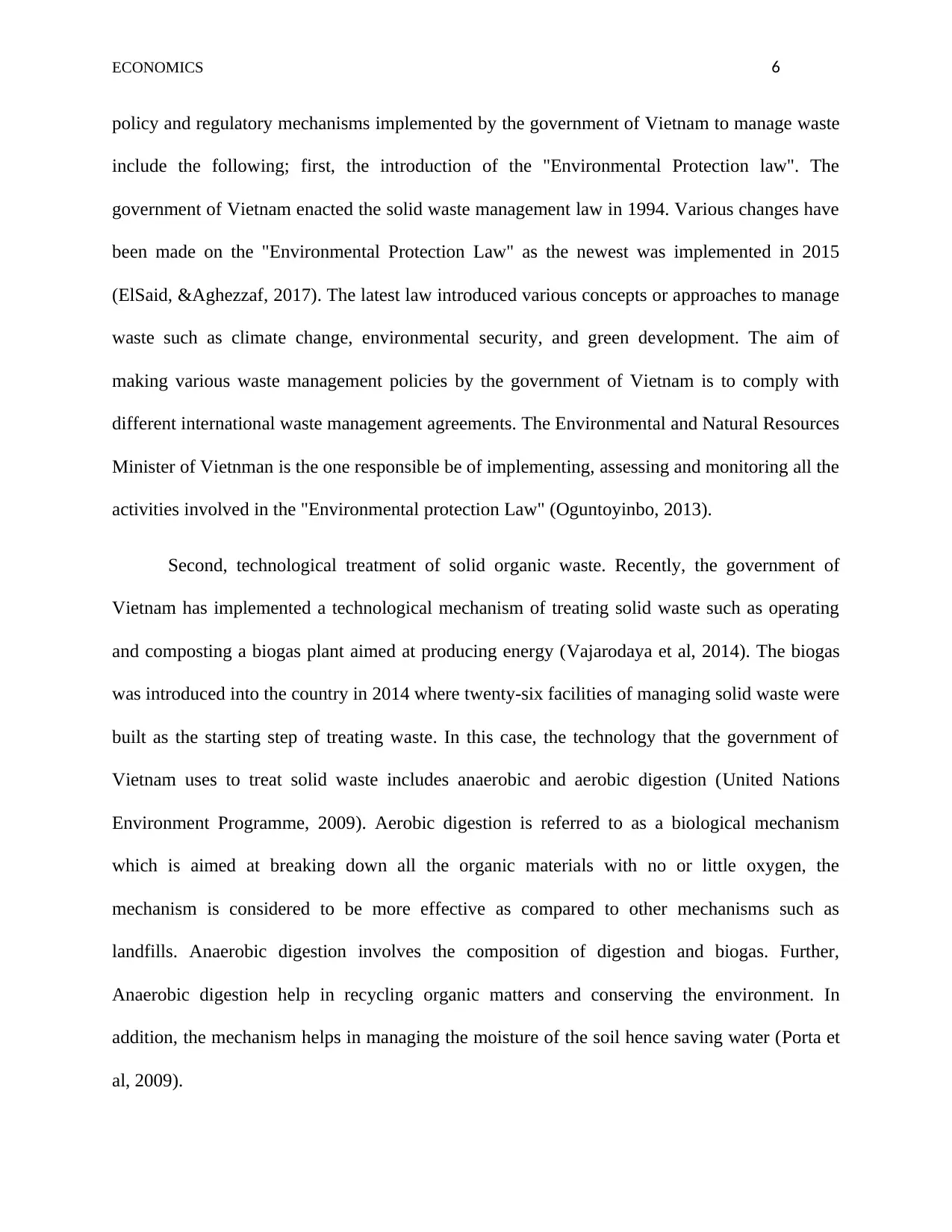
ECONOMICS 6
policy and regulatory mechanisms implemented by the government of Vietnam to manage waste
include the following; first, the introduction of the "Environmental Protection law". The
government of Vietnam enacted the solid waste management law in 1994. Various changes have
been made on the "Environmental Protection Law" as the newest was implemented in 2015
(ElSaid, &Aghezzaf, 2017). The latest law introduced various concepts or approaches to manage
waste such as climate change, environmental security, and green development. The aim of
making various waste management policies by the government of Vietnam is to comply with
different international waste management agreements. The Environmental and Natural Resources
Minister of Vietnman is the one responsible be of implementing, assessing and monitoring all the
activities involved in the "Environmental protection Law" (Oguntoyinbo, 2013).
Second, technological treatment of solid organic waste. Recently, the government of
Vietnam has implemented a technological mechanism of treating solid waste such as operating
and composting a biogas plant aimed at producing energy (Vajarodaya et al, 2014). The biogas
was introduced into the country in 2014 where twenty-six facilities of managing solid waste were
built as the starting step of treating waste. In this case, the technology that the government of
Vietnam uses to treat solid waste includes anaerobic and aerobic digestion (United Nations
Environment Programme, 2009). Aerobic digestion is referred to as a biological mechanism
which is aimed at breaking down all the organic materials with no or little oxygen, the
mechanism is considered to be more effective as compared to other mechanisms such as
landfills. Anaerobic digestion involves the composition of digestion and biogas. Further,
Anaerobic digestion help in recycling organic matters and conserving the environment. In
addition, the mechanism helps in managing the moisture of the soil hence saving water (Porta et
al, 2009).
policy and regulatory mechanisms implemented by the government of Vietnam to manage waste
include the following; first, the introduction of the "Environmental Protection law". The
government of Vietnam enacted the solid waste management law in 1994. Various changes have
been made on the "Environmental Protection Law" as the newest was implemented in 2015
(ElSaid, &Aghezzaf, 2017). The latest law introduced various concepts or approaches to manage
waste such as climate change, environmental security, and green development. The aim of
making various waste management policies by the government of Vietnam is to comply with
different international waste management agreements. The Environmental and Natural Resources
Minister of Vietnman is the one responsible be of implementing, assessing and monitoring all the
activities involved in the "Environmental protection Law" (Oguntoyinbo, 2013).
Second, technological treatment of solid organic waste. Recently, the government of
Vietnam has implemented a technological mechanism of treating solid waste such as operating
and composting a biogas plant aimed at producing energy (Vajarodaya et al, 2014). The biogas
was introduced into the country in 2014 where twenty-six facilities of managing solid waste were
built as the starting step of treating waste. In this case, the technology that the government of
Vietnam uses to treat solid waste includes anaerobic and aerobic digestion (United Nations
Environment Programme, 2009). Aerobic digestion is referred to as a biological mechanism
which is aimed at breaking down all the organic materials with no or little oxygen, the
mechanism is considered to be more effective as compared to other mechanisms such as
landfills. Anaerobic digestion involves the composition of digestion and biogas. Further,
Anaerobic digestion help in recycling organic matters and conserving the environment. In
addition, the mechanism helps in managing the moisture of the soil hence saving water (Porta et
al, 2009).
⊘ This is a preview!⊘
Do you want full access?
Subscribe today to unlock all pages.

Trusted by 1+ million students worldwide
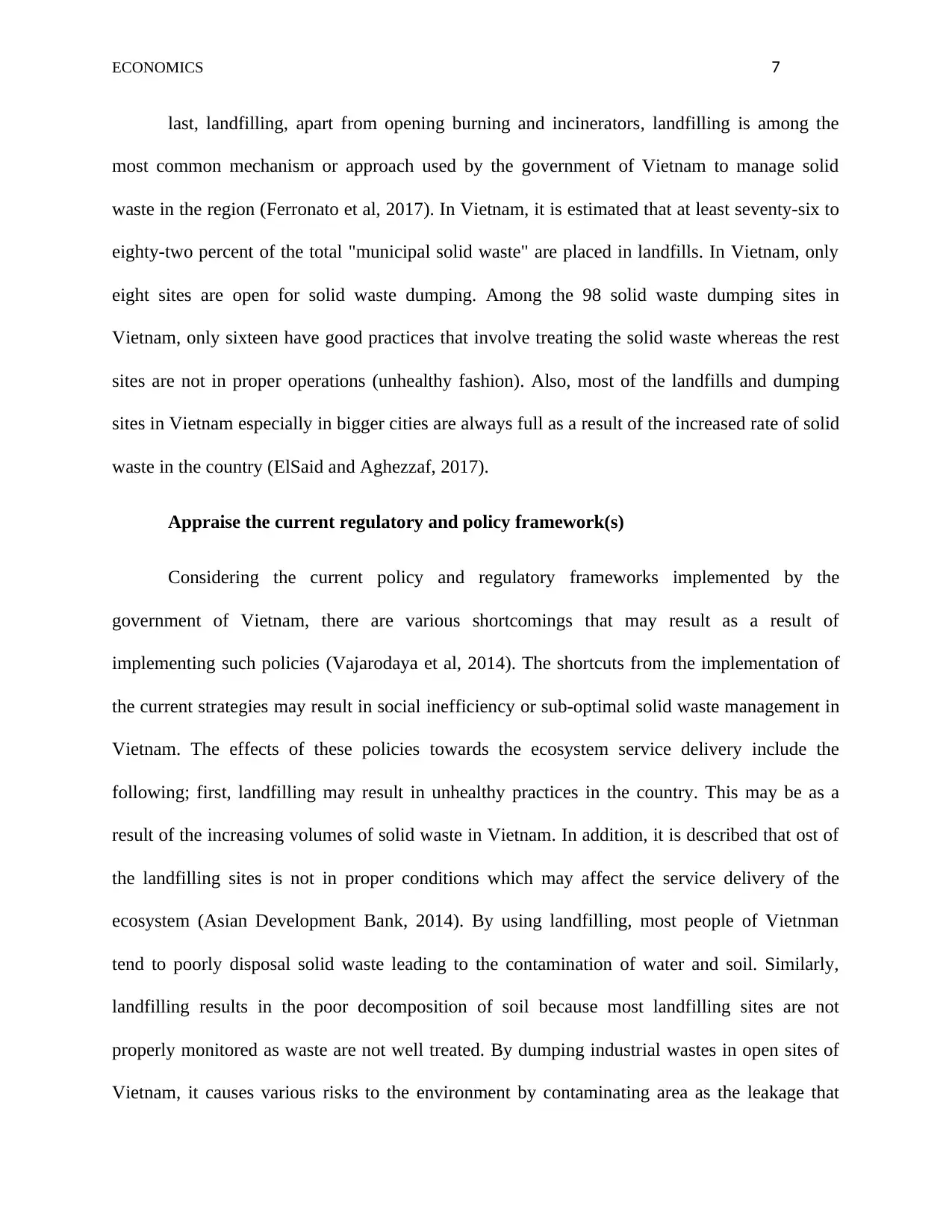
ECONOMICS 7
last, landfilling, apart from opening burning and incinerators, landfilling is among the
most common mechanism or approach used by the government of Vietnam to manage solid
waste in the region (Ferronato et al, 2017). In Vietnam, it is estimated that at least seventy-six to
eighty-two percent of the total "municipal solid waste" are placed in landfills. In Vietnam, only
eight sites are open for solid waste dumping. Among the 98 solid waste dumping sites in
Vietnam, only sixteen have good practices that involve treating the solid waste whereas the rest
sites are not in proper operations (unhealthy fashion). Also, most of the landfills and dumping
sites in Vietnam especially in bigger cities are always full as a result of the increased rate of solid
waste in the country (ElSaid and Aghezzaf, 2017).
Appraise the current regulatory and policy framework(s)
Considering the current policy and regulatory frameworks implemented by the
government of Vietnam, there are various shortcomings that may result as a result of
implementing such policies (Vajarodaya et al, 2014). The shortcuts from the implementation of
the current strategies may result in social inefficiency or sub-optimal solid waste management in
Vietnam. The effects of these policies towards the ecosystem service delivery include the
following; first, landfilling may result in unhealthy practices in the country. This may be as a
result of the increasing volumes of solid waste in Vietnam. In addition, it is described that ost of
the landfilling sites is not in proper conditions which may affect the service delivery of the
ecosystem (Asian Development Bank, 2014). By using landfilling, most people of Vietnman
tend to poorly disposal solid waste leading to the contamination of water and soil. Similarly,
landfilling results in the poor decomposition of soil because most landfilling sites are not
properly monitored as waste are not well treated. By dumping industrial wastes in open sites of
Vietnam, it causes various risks to the environment by contaminating area as the leakage that
last, landfilling, apart from opening burning and incinerators, landfilling is among the
most common mechanism or approach used by the government of Vietnam to manage solid
waste in the region (Ferronato et al, 2017). In Vietnam, it is estimated that at least seventy-six to
eighty-two percent of the total "municipal solid waste" are placed in landfills. In Vietnam, only
eight sites are open for solid waste dumping. Among the 98 solid waste dumping sites in
Vietnam, only sixteen have good practices that involve treating the solid waste whereas the rest
sites are not in proper operations (unhealthy fashion). Also, most of the landfills and dumping
sites in Vietnam especially in bigger cities are always full as a result of the increased rate of solid
waste in the country (ElSaid and Aghezzaf, 2017).
Appraise the current regulatory and policy framework(s)
Considering the current policy and regulatory frameworks implemented by the
government of Vietnam, there are various shortcomings that may result as a result of
implementing such policies (Vajarodaya et al, 2014). The shortcuts from the implementation of
the current strategies may result in social inefficiency or sub-optimal solid waste management in
Vietnam. The effects of these policies towards the ecosystem service delivery include the
following; first, landfilling may result in unhealthy practices in the country. This may be as a
result of the increasing volumes of solid waste in Vietnam. In addition, it is described that ost of
the landfilling sites is not in proper conditions which may affect the service delivery of the
ecosystem (Asian Development Bank, 2014). By using landfilling, most people of Vietnman
tend to poorly disposal solid waste leading to the contamination of water and soil. Similarly,
landfilling results in the poor decomposition of soil because most landfilling sites are not
properly monitored as waste are not well treated. By dumping industrial wastes in open sites of
Vietnam, it causes various risks to the environment by contaminating area as the leakage that
Paraphrase This Document
Need a fresh take? Get an instant paraphrase of this document with our AI Paraphraser
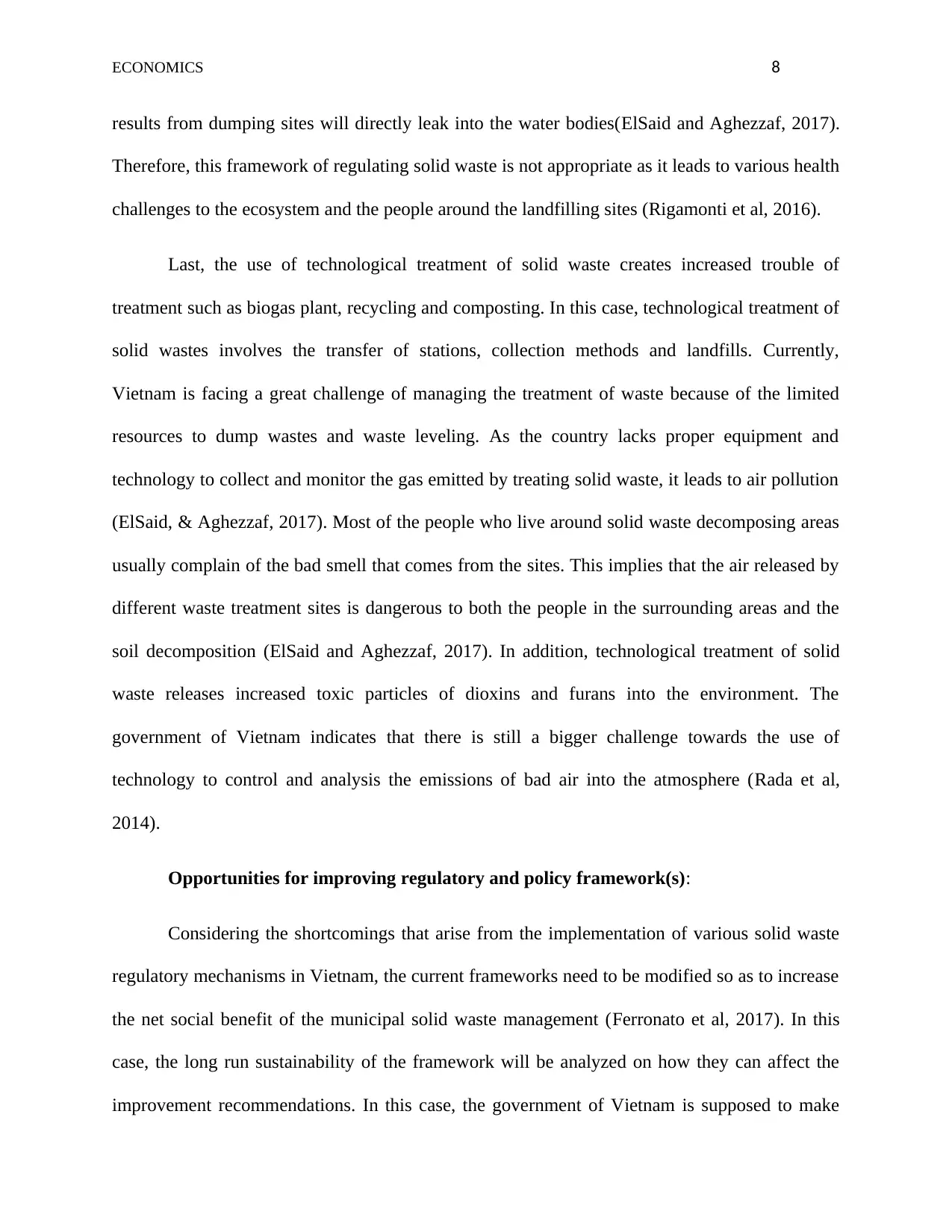
ECONOMICS 8
results from dumping sites will directly leak into the water bodies(ElSaid and Aghezzaf, 2017).
Therefore, this framework of regulating solid waste is not appropriate as it leads to various health
challenges to the ecosystem and the people around the landfilling sites (Rigamonti et al, 2016).
Last, the use of technological treatment of solid waste creates increased trouble of
treatment such as biogas plant, recycling and composting. In this case, technological treatment of
solid wastes involves the transfer of stations, collection methods and landfills. Currently,
Vietnam is facing a great challenge of managing the treatment of waste because of the limited
resources to dump wastes and waste leveling. As the country lacks proper equipment and
technology to collect and monitor the gas emitted by treating solid waste, it leads to air pollution
(ElSaid, & Aghezzaf, 2017). Most of the people who live around solid waste decomposing areas
usually complain of the bad smell that comes from the sites. This implies that the air released by
different waste treatment sites is dangerous to both the people in the surrounding areas and the
soil decomposition (ElSaid and Aghezzaf, 2017). In addition, technological treatment of solid
waste releases increased toxic particles of dioxins and furans into the environment. The
government of Vietnam indicates that there is still a bigger challenge towards the use of
technology to control and analysis the emissions of bad air into the atmosphere (Rada et al,
2014).
Opportunities for improving regulatory and policy framework(s):
Considering the shortcomings that arise from the implementation of various solid waste
regulatory mechanisms in Vietnam, the current frameworks need to be modified so as to increase
the net social benefit of the municipal solid waste management (Ferronato et al, 2017). In this
case, the long run sustainability of the framework will be analyzed on how they can affect the
improvement recommendations. In this case, the government of Vietnam is supposed to make
results from dumping sites will directly leak into the water bodies(ElSaid and Aghezzaf, 2017).
Therefore, this framework of regulating solid waste is not appropriate as it leads to various health
challenges to the ecosystem and the people around the landfilling sites (Rigamonti et al, 2016).
Last, the use of technological treatment of solid waste creates increased trouble of
treatment such as biogas plant, recycling and composting. In this case, technological treatment of
solid wastes involves the transfer of stations, collection methods and landfills. Currently,
Vietnam is facing a great challenge of managing the treatment of waste because of the limited
resources to dump wastes and waste leveling. As the country lacks proper equipment and
technology to collect and monitor the gas emitted by treating solid waste, it leads to air pollution
(ElSaid, & Aghezzaf, 2017). Most of the people who live around solid waste decomposing areas
usually complain of the bad smell that comes from the sites. This implies that the air released by
different waste treatment sites is dangerous to both the people in the surrounding areas and the
soil decomposition (ElSaid and Aghezzaf, 2017). In addition, technological treatment of solid
waste releases increased toxic particles of dioxins and furans into the environment. The
government of Vietnam indicates that there is still a bigger challenge towards the use of
technology to control and analysis the emissions of bad air into the atmosphere (Rada et al,
2014).
Opportunities for improving regulatory and policy framework(s):
Considering the shortcomings that arise from the implementation of various solid waste
regulatory mechanisms in Vietnam, the current frameworks need to be modified so as to increase
the net social benefit of the municipal solid waste management (Ferronato et al, 2017). In this
case, the long run sustainability of the framework will be analyzed on how they can affect the
improvement recommendations. In this case, the government of Vietnam is supposed to make
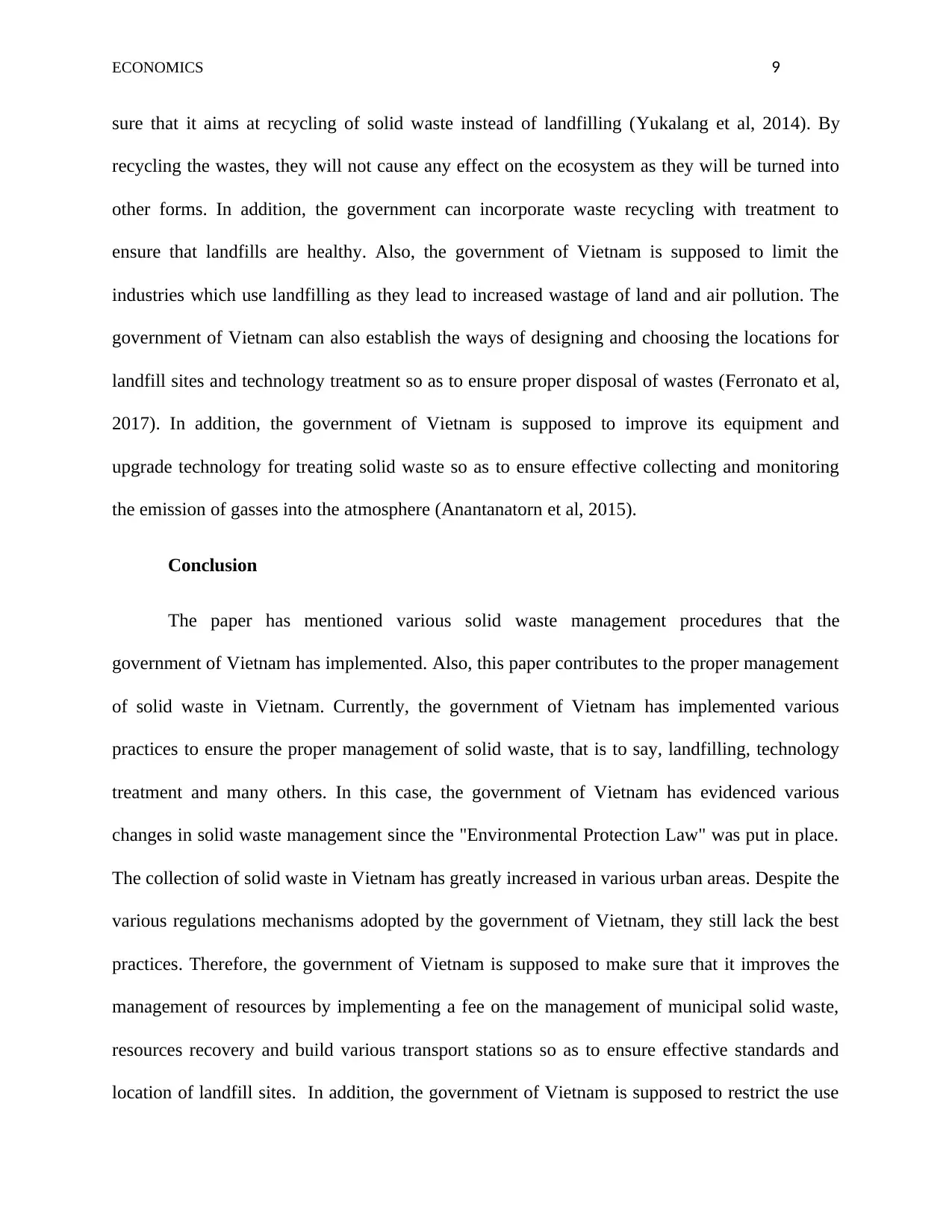
ECONOMICS 9
sure that it aims at recycling of solid waste instead of landfilling (Yukalang et al, 2014). By
recycling the wastes, they will not cause any effect on the ecosystem as they will be turned into
other forms. In addition, the government can incorporate waste recycling with treatment to
ensure that landfills are healthy. Also, the government of Vietnam is supposed to limit the
industries which use landfilling as they lead to increased wastage of land and air pollution. The
government of Vietnam can also establish the ways of designing and choosing the locations for
landfill sites and technology treatment so as to ensure proper disposal of wastes (Ferronato et al,
2017). In addition, the government of Vietnam is supposed to improve its equipment and
upgrade technology for treating solid waste so as to ensure effective collecting and monitoring
the emission of gasses into the atmosphere (Anantanatorn et al, 2015).
Conclusion
The paper has mentioned various solid waste management procedures that the
government of Vietnam has implemented. Also, this paper contributes to the proper management
of solid waste in Vietnam. Currently, the government of Vietnam has implemented various
practices to ensure the proper management of solid waste, that is to say, landfilling, technology
treatment and many others. In this case, the government of Vietnam has evidenced various
changes in solid waste management since the "Environmental Protection Law" was put in place.
The collection of solid waste in Vietnam has greatly increased in various urban areas. Despite the
various regulations mechanisms adopted by the government of Vietnam, they still lack the best
practices. Therefore, the government of Vietnam is supposed to make sure that it improves the
management of resources by implementing a fee on the management of municipal solid waste,
resources recovery and build various transport stations so as to ensure effective standards and
location of landfill sites. In addition, the government of Vietnam is supposed to restrict the use
sure that it aims at recycling of solid waste instead of landfilling (Yukalang et al, 2014). By
recycling the wastes, they will not cause any effect on the ecosystem as they will be turned into
other forms. In addition, the government can incorporate waste recycling with treatment to
ensure that landfills are healthy. Also, the government of Vietnam is supposed to limit the
industries which use landfilling as they lead to increased wastage of land and air pollution. The
government of Vietnam can also establish the ways of designing and choosing the locations for
landfill sites and technology treatment so as to ensure proper disposal of wastes (Ferronato et al,
2017). In addition, the government of Vietnam is supposed to improve its equipment and
upgrade technology for treating solid waste so as to ensure effective collecting and monitoring
the emission of gasses into the atmosphere (Anantanatorn et al, 2015).
Conclusion
The paper has mentioned various solid waste management procedures that the
government of Vietnam has implemented. Also, this paper contributes to the proper management
of solid waste in Vietnam. Currently, the government of Vietnam has implemented various
practices to ensure the proper management of solid waste, that is to say, landfilling, technology
treatment and many others. In this case, the government of Vietnam has evidenced various
changes in solid waste management since the "Environmental Protection Law" was put in place.
The collection of solid waste in Vietnam has greatly increased in various urban areas. Despite the
various regulations mechanisms adopted by the government of Vietnam, they still lack the best
practices. Therefore, the government of Vietnam is supposed to make sure that it improves the
management of resources by implementing a fee on the management of municipal solid waste,
resources recovery and build various transport stations so as to ensure effective standards and
location of landfill sites. In addition, the government of Vietnam is supposed to restrict the use
⊘ This is a preview!⊘
Do you want full access?
Subscribe today to unlock all pages.

Trusted by 1+ million students worldwide
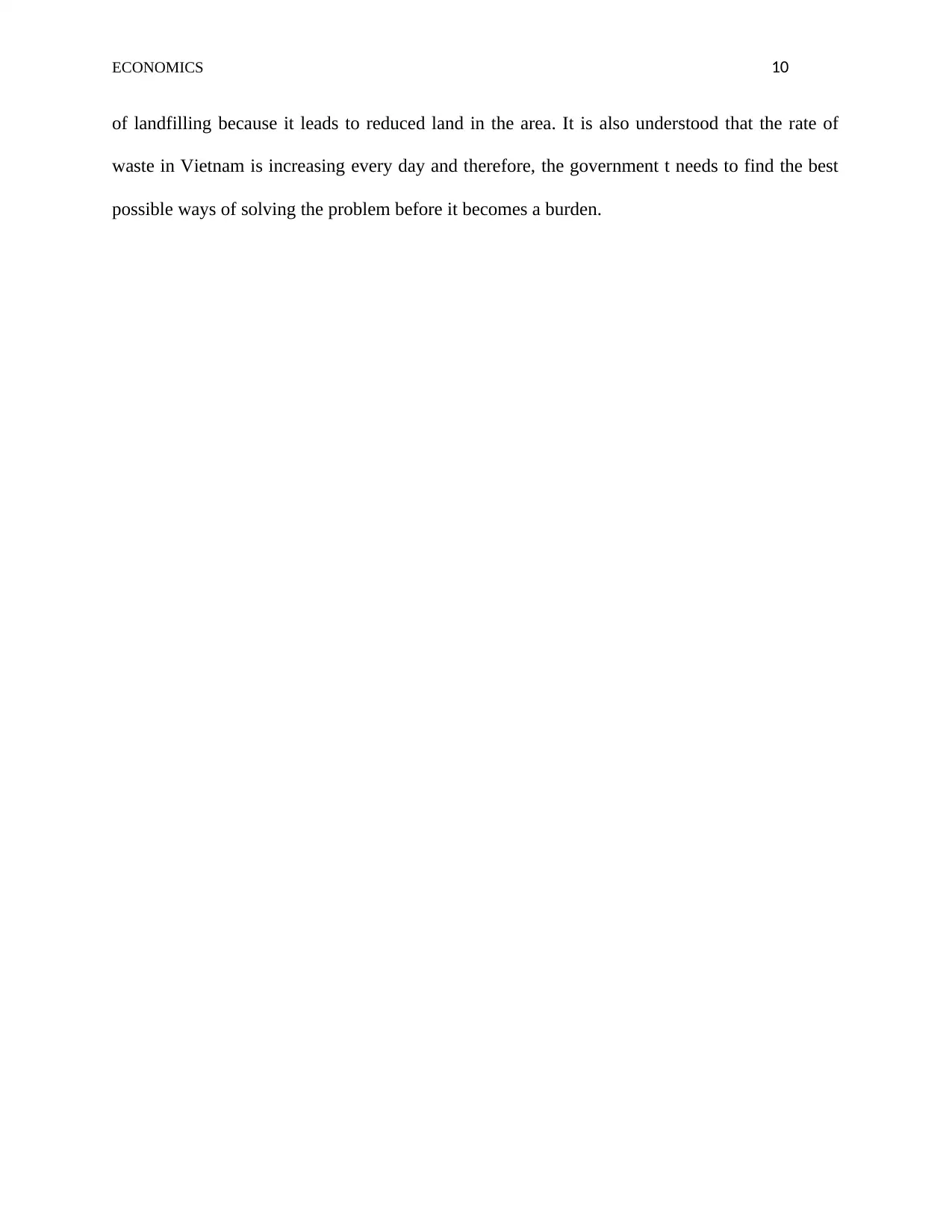
ECONOMICS 10
of landfilling because it leads to reduced land in the area. It is also understood that the rate of
waste in Vietnam is increasing every day and therefore, the government t needs to find the best
possible ways of solving the problem before it becomes a burden.
of landfilling because it leads to reduced land in the area. It is also understood that the rate of
waste in Vietnam is increasing every day and therefore, the government t needs to find the best
possible ways of solving the problem before it becomes a burden.
Paraphrase This Document
Need a fresh take? Get an instant paraphrase of this document with our AI Paraphraser
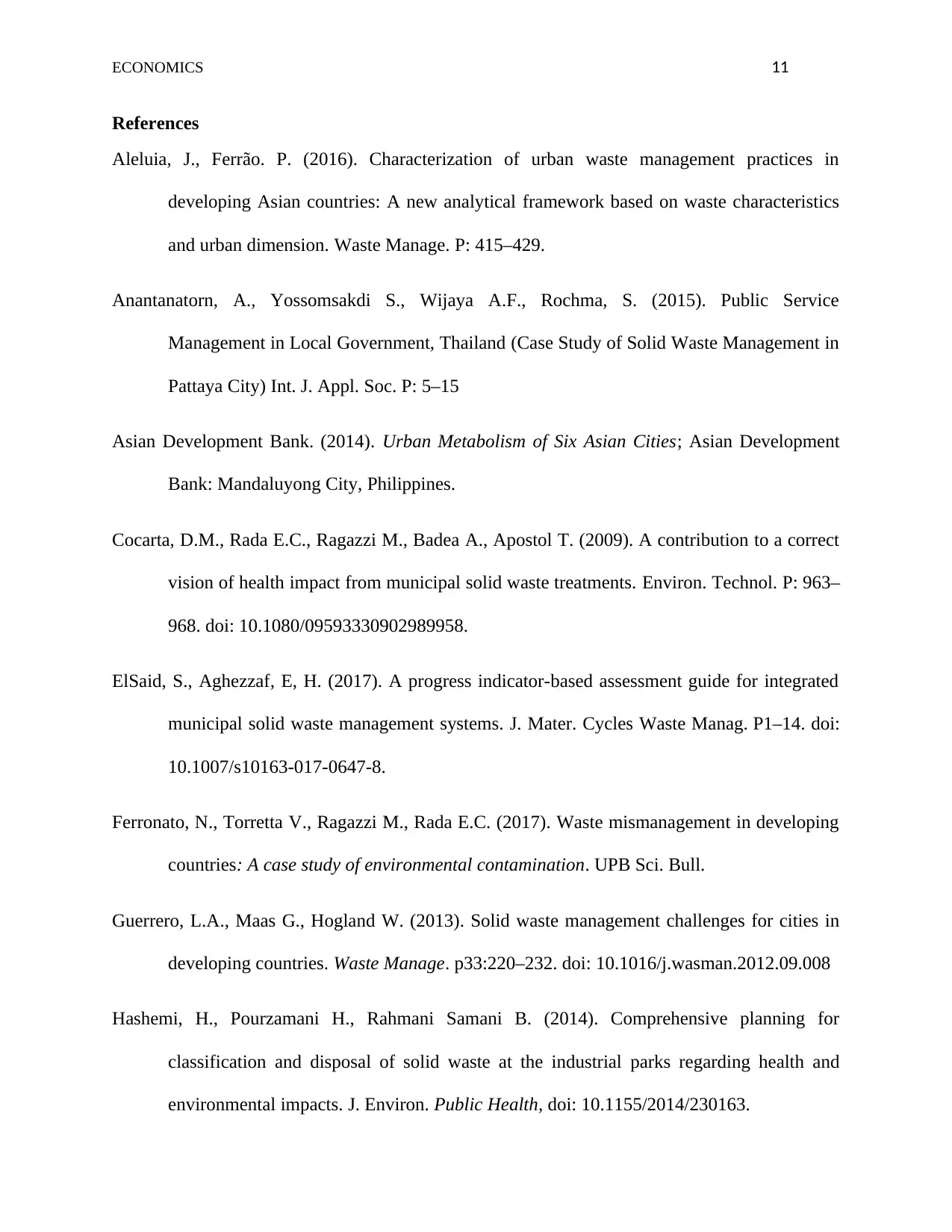
ECONOMICS 11
References
Aleluia, J., Ferrão. P. (2016). Characterization of urban waste management practices in
developing Asian countries: A new analytical framework based on waste characteristics
and urban dimension. Waste Manage. P: 415–429.
Anantanatorn, A., Yossomsakdi S., Wijaya A.F., Rochma, S. (2015). Public Service
Management in Local Government, Thailand (Case Study of Solid Waste Management in
Pattaya City) Int. J. Appl. Soc. P: 5–15
Asian Development Bank. (2014). Urban Metabolism of Six Asian Cities; Asian Development
Bank: Mandaluyong City, Philippines.
Cocarta, D.M., Rada E.C., Ragazzi M., Badea A., Apostol T. (2009). A contribution to a correct
vision of health impact from municipal solid waste treatments. Environ. Technol. P: 963–
968. doi: 10.1080/09593330902989958.
ElSaid, S., Aghezzaf, E, H. (2017). A progress indicator-based assessment guide for integrated
municipal solid waste management systems. J. Mater. Cycles Waste Manag. P1–14. doi:
10.1007/s10163-017-0647-8.
Ferronato, N., Torretta V., Ragazzi M., Rada E.C. (2017). Waste mismanagement in developing
countries: A case study of environmental contamination. UPB Sci. Bull.
Guerrero, L.A., Maas G., Hogland W. (2013). Solid waste management challenges for cities in
developing countries. Waste Manage. p33:220–232. doi: 10.1016/j.wasman.2012.09.008
Hashemi, H., Pourzamani H., Rahmani Samani B. (2014). Comprehensive planning for
classification and disposal of solid waste at the industrial parks regarding health and
environmental impacts. J. Environ. Public Health, doi: 10.1155/2014/230163.
References
Aleluia, J., Ferrão. P. (2016). Characterization of urban waste management practices in
developing Asian countries: A new analytical framework based on waste characteristics
and urban dimension. Waste Manage. P: 415–429.
Anantanatorn, A., Yossomsakdi S., Wijaya A.F., Rochma, S. (2015). Public Service
Management in Local Government, Thailand (Case Study of Solid Waste Management in
Pattaya City) Int. J. Appl. Soc. P: 5–15
Asian Development Bank. (2014). Urban Metabolism of Six Asian Cities; Asian Development
Bank: Mandaluyong City, Philippines.
Cocarta, D.M., Rada E.C., Ragazzi M., Badea A., Apostol T. (2009). A contribution to a correct
vision of health impact from municipal solid waste treatments. Environ. Technol. P: 963–
968. doi: 10.1080/09593330902989958.
ElSaid, S., Aghezzaf, E, H. (2017). A progress indicator-based assessment guide for integrated
municipal solid waste management systems. J. Mater. Cycles Waste Manag. P1–14. doi:
10.1007/s10163-017-0647-8.
Ferronato, N., Torretta V., Ragazzi M., Rada E.C. (2017). Waste mismanagement in developing
countries: A case study of environmental contamination. UPB Sci. Bull.
Guerrero, L.A., Maas G., Hogland W. (2013). Solid waste management challenges for cities in
developing countries. Waste Manage. p33:220–232. doi: 10.1016/j.wasman.2012.09.008
Hashemi, H., Pourzamani H., Rahmani Samani B. (2014). Comprehensive planning for
classification and disposal of solid waste at the industrial parks regarding health and
environmental impacts. J. Environ. Public Health, doi: 10.1155/2014/230163.
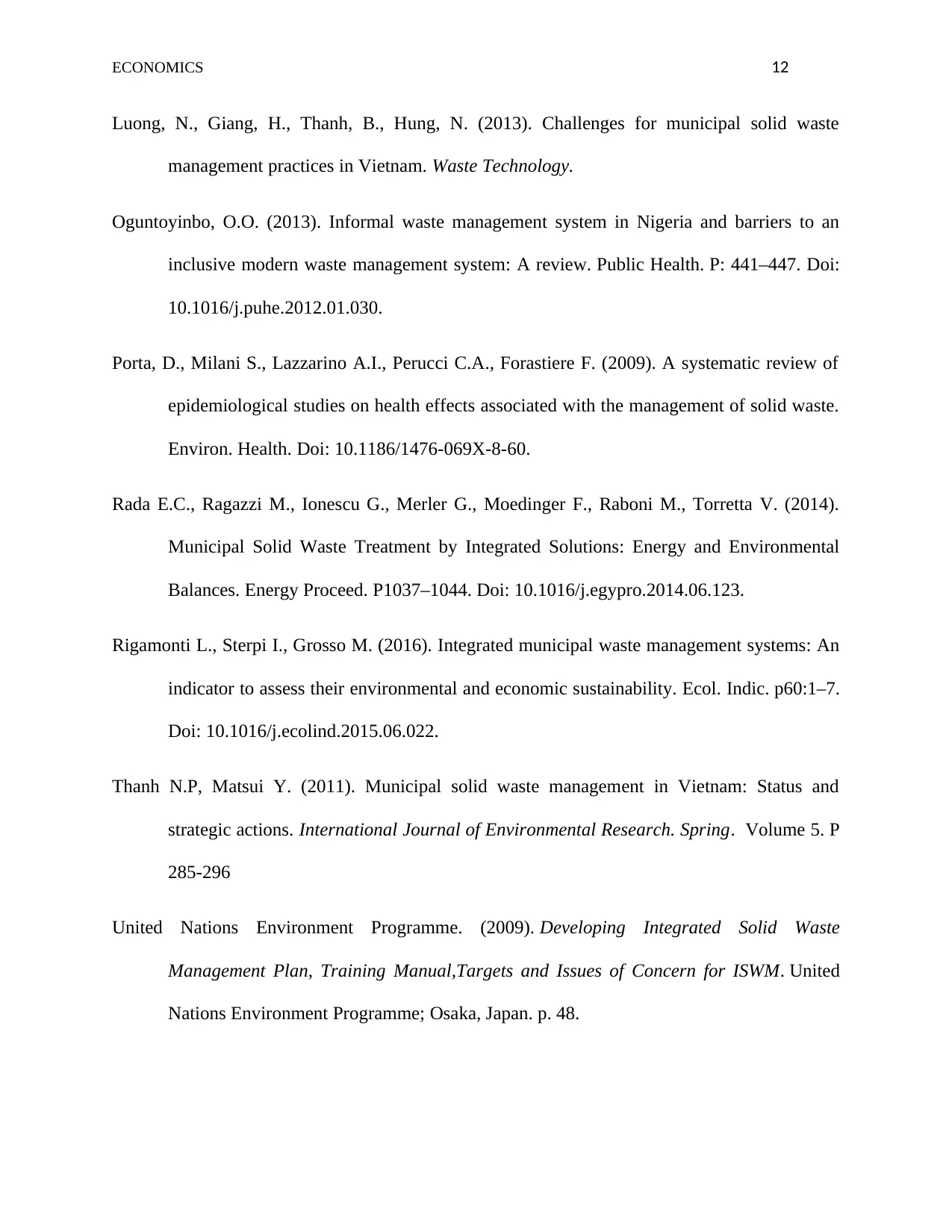
ECONOMICS 12
Luong, N., Giang, H., Thanh, B., Hung, N. (2013). Challenges for municipal solid waste
management practices in Vietnam. Waste Technology.
Oguntoyinbo, O.O. (2013). Informal waste management system in Nigeria and barriers to an
inclusive modern waste management system: A review. Public Health. P: 441–447. Doi:
10.1016/j.puhe.2012.01.030.
Porta, D., Milani S., Lazzarino A.I., Perucci C.A., Forastiere F. (2009). A systematic review of
epidemiological studies on health effects associated with the management of solid waste.
Environ. Health. Doi: 10.1186/1476-069X-8-60.
Rada E.C., Ragazzi M., Ionescu G., Merler G., Moedinger F., Raboni M., Torretta V. (2014).
Municipal Solid Waste Treatment by Integrated Solutions: Energy and Environmental
Balances. Energy Proceed. P1037–1044. Doi: 10.1016/j.egypro.2014.06.123.
Rigamonti L., Sterpi I., Grosso M. (2016). Integrated municipal waste management systems: An
indicator to assess their environmental and economic sustainability. Ecol. Indic. p60:1–7.
Doi: 10.1016/j.ecolind.2015.06.022.
Thanh N.P, Matsui Y. (2011). Municipal solid waste management in Vietnam: Status and
strategic actions. International Journal of Environmental Research. Spring. Volume 5. P
285-296
United Nations Environment Programme. (2009). Developing Integrated Solid Waste
Management Plan, Training Manual,Targets and Issues of Concern for ISWM. United
Nations Environment Programme; Osaka, Japan. p. 48.
Luong, N., Giang, H., Thanh, B., Hung, N. (2013). Challenges for municipal solid waste
management practices in Vietnam. Waste Technology.
Oguntoyinbo, O.O. (2013). Informal waste management system in Nigeria and barriers to an
inclusive modern waste management system: A review. Public Health. P: 441–447. Doi:
10.1016/j.puhe.2012.01.030.
Porta, D., Milani S., Lazzarino A.I., Perucci C.A., Forastiere F. (2009). A systematic review of
epidemiological studies on health effects associated with the management of solid waste.
Environ. Health. Doi: 10.1186/1476-069X-8-60.
Rada E.C., Ragazzi M., Ionescu G., Merler G., Moedinger F., Raboni M., Torretta V. (2014).
Municipal Solid Waste Treatment by Integrated Solutions: Energy and Environmental
Balances. Energy Proceed. P1037–1044. Doi: 10.1016/j.egypro.2014.06.123.
Rigamonti L., Sterpi I., Grosso M. (2016). Integrated municipal waste management systems: An
indicator to assess their environmental and economic sustainability. Ecol. Indic. p60:1–7.
Doi: 10.1016/j.ecolind.2015.06.022.
Thanh N.P, Matsui Y. (2011). Municipal solid waste management in Vietnam: Status and
strategic actions. International Journal of Environmental Research. Spring. Volume 5. P
285-296
United Nations Environment Programme. (2009). Developing Integrated Solid Waste
Management Plan, Training Manual,Targets and Issues of Concern for ISWM. United
Nations Environment Programme; Osaka, Japan. p. 48.
⊘ This is a preview!⊘
Do you want full access?
Subscribe today to unlock all pages.

Trusted by 1+ million students worldwide
1 out of 13
Related Documents
Your All-in-One AI-Powered Toolkit for Academic Success.
+13062052269
info@desklib.com
Available 24*7 on WhatsApp / Email
![[object Object]](/_next/static/media/star-bottom.7253800d.svg)
Unlock your academic potential
Copyright © 2020–2025 A2Z Services. All Rights Reserved. Developed and managed by ZUCOL.




